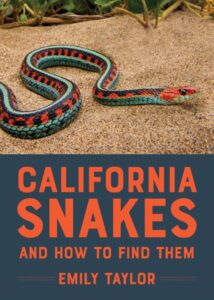 If I was asked to pick the most beautiful snake in the United States, I would not hesitate for a single moment; it would be the San Francisco Garter Snake, Thamnophis sirtalis tetrataenia. This vividly-coloured subspecies of the Common Garter Snake is an almost unbelievable combination of teal, dark red-orange, and black. Unfortunately, this remarkable colouration has made it a favourite of collectors, which combined with its very small natural range has imperiled its continued existence. Indeed, it has been classified as “Endangered, Wherever Found” the U. S. Endangered Species List since March of 1967. I have never seen one in life; however I have seen many images of them; most recently on the cover of Prof. Emily Taylor’s new California Snakes and How to Find Them.
If I was asked to pick the most beautiful snake in the United States, I would not hesitate for a single moment; it would be the San Francisco Garter Snake, Thamnophis sirtalis tetrataenia. This vividly-coloured subspecies of the Common Garter Snake is an almost unbelievable combination of teal, dark red-orange, and black. Unfortunately, this remarkable colouration has made it a favourite of collectors, which combined with its very small natural range has imperiled its continued existence. Indeed, it has been classified as “Endangered, Wherever Found” the U. S. Endangered Species List since March of 1967. I have never seen one in life; however I have seen many images of them; most recently on the cover of Prof. Emily Taylor’s new California Snakes and How to Find Them.
I have often in the past praised the publisher of California Snakes – Heyday Books – for the consistently high level of dedication they have shown to the natural history community in publishing particularly well-written and useful guidebooks to the plants, wildlife, and ecosystems of the U.S. state of California. Now, with the publication of this new book, I have yet another reason to do so.
As with so many previous Heyday published guidebooks, in California Snakes Prof. Taylor presents her subject matter squarely at the level of most utility for an amateur naturalist, or as she describes it in the very first sentence of the book’s preface, “This book is for snake lovers and snake lovers-to-be.” It’s both a reference tool as well as an invitation, reminding me somewhat in this of the superb four book series about common ants by Dr. Eleanor Spicer Rice.
Beginning with a general overview of the natural history of snakes and how to approach them – both figuratively and physically – California Snakes then presents forty-eight species profiles, complete with full-colour photographs, of course, each providing the interested reader with a general introduction to that species, followed by information on the species’ appearance, natural history, range and variations, information about how to find it, and a few final thoughts under the heading “Things You Might Like to Know.”
If you live in, or a planning to visit to, California (and even if you are not either of these, it is still worth noting as it covers nearly one-third of the total described species of snakes in the United States) and you have an interest in snakes – or would like to develop one – this is a book that should most certainly be on your list for your next visit to your local book shop.
